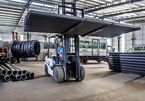According to the Ministry of Planning and Investment’s report, the processing and manufacturing industry achieved a high growth rate of 11.42% during this period. This contributed to helping Vietnam's economy stand firm in 2021 and is expected to be a premise for growth recovery in the following years.
The "key" to prosperity
 |
However, this figure reveals some problems. Although the growth rate of the processing and manufacturing industry is higher than other industries, it is still quite low compared to the criteria of an industrialized country. The structure of Vietnam’s processing and manufacturing industry is problematic as the supporting industry has developed very slowly and the foreign-invested sector accounts for more than 50% of production value and about 80% of export turnover.
The Ministry of Planning and Investment forecasts that the world economy will recover strongly after the end of the Covid-19 pandemic. The epidemic has disrupted many supply chains. Therefore, this is an opportunity for Vietnamese enterprises to participate in the global supply chain. However, it is difficult for the manufacturing and processing industry, with most Vietnamese firms still doing outsourcing.
The processing and manufacturing industry has long proved its importance in the process of industrialization and economic development. From the rise of Britain in the 19th century, to the rise of the United States, Germany, and Japan in the 20th century and the newly industrialized countries in the second half of the 20th century, the success of these countries in the industrialization process proves that the manufacturing industry is the "key" to prosperity.
Reality also indicates that when the Covid-19 pandemic occurred all economies were affected, but the countries with a high proportion of manufacturing industries in their GDP were affected more slowly and mildly.
According to the Ministry of Industry and Trade, the proportion from the processing and manufacturing industry in Vietnam's GDP increased from 13.4% in 2016 to 16.58% in 2020.
Meanwhile, for industrialized countries, during the past 20 years the manufacturing industry has always contributed 20% or more to GDP. For example, China's manufacturing and processing industry contributes 27.1% of GDP; South Korea 25.3%; Thailand 25.3%; Malaysia 21.5%; Japan 20.7%... Developed countries have moved their production bases abroad, so the manufacturing capacity is much larger.
Vietnam with 100 million people, in order to be independent, self-reliant and prosperous, needs to have a strong and developing processing and manufacturing industry.
The Resolution of the 13th National Party Congress set a goal to increase the proportion of processing and manufacturing industry in GDP to over 25% in the period of 2021-2025.
FDI dependence and the low-value trap
 |
However, there are concerns that Vietnam can easily fall into the "low value-added trap". The United Nations Conference on Trade and Development (UNCTAD) says a country trapped in a low value-added trap attracts FDI from businesses that do not intend to form links with the domestic economy, cannot create spillover effects, and operate with short-term goals.
In recent years, Vietnam has led Southeast Asia in attracting foreign investment. Among foreign-invested projects in Vietnam, there are many projects of leading multinational corporations in many fields.
However, foreign-invested groups are creating their own economy, lacking connections to Vietnamese firms, and thus they do not bring in spillover effects. Many investors believe that low labor costs and energy prices as well as attractive tax incentives are the main reasons to invest in Vietnam. Very few foreign-invested corporations think that highly skilled workers or competitive domestic supply chains are Vietnam's strengths.
Vietnam needs to renew its strategy to attract foreign investment in general and the processing and manufacturing industry in particular to escape the middle-income trap.
With the manufacturing and processing industry, growth is mainly based on external resources (foreign-invested sector), and when domestic advantages no longer exist (low labor costs, attractive tax incentives...), foreign investors shift to countries with better advantages, which will lead to the process of industrial disarmament.
A country may be caught in the "low value-added trap" due to other reasons, mainly a weak and self-reliant domestic private sector which is unable to mature or become independent, or unable to master the economy and have enough competitive power in the global market. In essence, the “low value-added trap” is also a manifestation of the “middle income trap”.
In fact, in the period from 1951 to 1989, newly emerging economies in Asia all attracted large investment sources from developed countries. However, after 20-30 years, South Korea and Taiwan have built a strong industry that is no longer dependent and has global competitiveness.
Meanwhile, some economies in Southeast Asia such as Malaysia, Thailand, Indonesia and the Philippines have so far depended on foreign-invested enterprises in most industries.
Experts say that in order to avoid the "middle income trap" or "low value-added trap" and become a developed and high-income country, Vietnam needs to change its strategy to attract foreign investment in general and foreign investment in the processing and manufacturing industry in particular.
Vietnam must attach foreign investment attraction to national development strategies and plans, form supply chains and industrial clusters, and focus on industries and stages that create high added value, are environmentally friendly and use low energy-consumption technology.
However, foreign-invested enterprises in the processing and manufacturing industry are only a driving force. Domestic industrial enterprises are a solid foundation to help a country escape the "middle income trap". Therefore, it is necessary to build a strong domestic force that plays a leading role and forms a domestic supply chain.
Resolution 50/NQ-TW on orientations to perfect institutions and policies, and improve the quality and efficiency of foreign investment cooperation to 2030 of the Politburo emphasizes:
Firstly, the foreign-invested economic sector is an important component of the Vietnamese economy, which is encouraged and has created favorable conditions for long-term development, cooperation and healthy competition with other economic sectors. The State respects and protects the legitimate rights and interests of investors; and ensures the harmonization of interests between the State, investors and employees in the enterprise.
Secondly, it is necessary to build and perfect institutions and policies on foreign investment in line with development trends, approach international advanced standards and harmonize with international commitments, and ensure synchronization, consistency, openness, transparency and highly competitiveness.
Thirdly, the attraction of foreign investment must be selective, taking quality, efficiency, technology and environmental protection as the main evaluation criteria. Prioritizing projects with advanced technology, new, clean and modern technology.
Fourthly, as for foreign investment, Vietnam must diversify partners and investment forms, intertwine interests in foreign investment cooperation and organically connect with the domestic economic sector, in line with the orientation of restructuring the economy and sustainable development goals; protecting the environment, ensuring national defense, security, and order...
Tran Thuy

20 years for Vietnam to become rich and strong
If developing countries do not make breakthroughs during the golden population period, they will find it difficult to overcome the middle-income trap to become developed countries.

Vietnam seeks to avoid middle-income trap before time runs out and population ages
Vietnam has become richer, but it remains a lower middle-income country facing a risk of being left behind. It aims to become a high-income country by 2045.